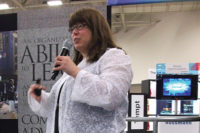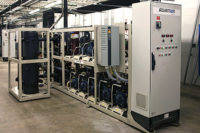The most recent National Restaurant Association Expo showcased some of the very latest in refrigeration technologies as related to ice machines and reach-in and walk-in freezers and coolers. Many will be coming to places of business in the near future. But, for now, here’s some early adopters putting tomorrow’s technology to use today.
Reach-In
Reaching in for produce at a Roundy’s Supermarket in Menomonee Falls, Wisconsin, doesn’t seem all that different than it always has, but that store is now using CO as a refrigerant — instead of a hydrochlorofluorocarbon (HCFC) or hydrofluorocarbon (HFC) — in a transcritical configuration.
CO2 systems are still relatively new to supermarket applications, and some question the higher capital cost involved with equipment using that refrigerant. But supermarket chains like Roundy’s are demonstrating the advantages of CO2, according to Hillphoenix, which provided its Advansor Transcritical booster system to the store. The company said successful installations will lead to further booster system utilization across its locations.
“The technology does cost more money, but the installation cost is lower than the price of similar systems we’re using elsewhere. Also, CO2 is cheaper on the operation side compared to glycol and other refrigerants,” said James Hyland, vice president, investor, and corporate communications, Roundy’s.
Roundy’s selection of the Micro Thermo Case Controller and Micro Thermo Transcritical Rack Controller optimized the Advansor system by ensuring precise control over case operation, leading to lower energy usage and reducing temperature shocks to food, Hyland said.
The store in the Milwaukee suburb opened in January 2014. “We will be conducting an energy analysis through all four seasons,” Hyland added. “We know what to expect from the system, and it appears the cost of the system balances out with comparable systems due to lower installation and operating costs.”
Ice Machines and Walk-ins
The Food Service Technology Center (FSTC) of Pacific Gas & Electric regularly becomes involved in energy-efficiency projects. One such project involved the Comal Restaurant that occupies a once-abandoned commercial space adjacent to a subway station within Berkeley, California’s art district.
The restaurant, built in 1927, features a secluded rear patio with a bar, an al fresco beer garden with a fire pit, and a covered dining area.
According to information supplied by FSTC, the refrigeration aspects included a walk-in cooler from True Mfg. Co. with all features required by CA Title 20 Appliance Energy Efficiency (such state standards are considered among the strictest in the nation). To achieve the standard, evaporator fan ECMs, a plastic strip curtain, and auto-door closer were used.
The facility’s state-of-the-art refrigeration system also included a nugget ice machine from Manitowoc Foodservice, which the center described as a top-tier Energy Star-rated ice machine. The project also included a high-efficiency condensing water heater and a low-flow pre-rinse sprayer and dish machine.
Condenser for a Cooler
A convenience store in the Northeast U.S. had a walk-in cooler powered by an old hermetic reciprocating compressor that needed replacement because it was loud and did not provide accurate temperature control during busy months. Numerous service calls were needed for failed components, which often required hours of diagnostics.
The owner of the store was seeking a solution that greatly reduced service calls and included built-in diagnostics.
The decision was to use a Copeland Scroll outdoor condensing unit from Emerson Climate Technologies. The unit had integrated controls, variable-speed PSC fan motors, large condenser coils for heat transfer, liquid flood-back prediction, and logic to protect the compressor. The use of scroll compressors further assisted with the noise concern.
Emerson said the use of the PerformanceAlert™ controller allowed for accuracy in the diagnosis of field issues, helping in the servicing and reducing of repair expenses.
Ammonia Application
A distribution center for a 190-store retail chain converted from HCFC-22 to an ammonia refrigeration system while using a more recent development in valve technology.
Tom Cooper, president of Refrigeration Concepts Inc., Comstock Park, Michigan, said his company was contracted to convert a 75,000-square-foot cold storage facility in Lansing, Michigan, requiring minus 10?F refrigeration for frozen meats and vegetables, from R-22 to ammonia by utilizing existing penthouses and maintaining temperatures during the process of demolition and reconstruction.
As part of the process, Cooper relied on the Danfoss Flexline™ valve platform technology to save time.
Cooper noted that valve trains, or stations, are used in ammonia systems to control the circulation of refrigerant in the system. The valves open and close to regulate the flow of refrigerant from compressors to heat exchangers to evaporator coils to condensers. “There is a lot of welding and integration of large numbers of valves and sensors from multiple suppliers when you fabricate a valve train from scratch,” said Cooper. “We’ve found the Flexline valve platform is much faster and better.”
Cooper used two Flexline configurations. The ICV Flexline family consists of ICM motorized valves and ICS piloted controlled servo valves. In contrast, the ICF Flexline station has a single-valve body with multiple port openings. This allows different components to be specified and installed at the factory to build the required configuration.
“Both Flexline platforms are based on one common valve body to offer outstanding flexibility,” said Cooper. “That lets us replace a string of valves with just one valve station.”
Publication date: 7/7/2014
Want more HVAC industry news and information? Join The NEWS on Facebook, Twitter, and LinkedIn today!








